Shamanism and Revealed Religion
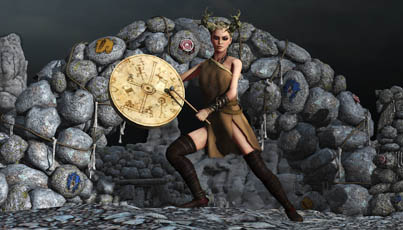
Siberia. The World Tree. Spirits.
Egypt. Melchizedek. One God.
The Huluppu Tree
Gilgamesh then loosened the roots of the huluppa-tree;
And the sons of the city, who accompanied him, cut off the branches.
From the trunk of the tree he carved a throne for his holy sister.
From the trunk of the tree Gilgamesh carved a bed for Inanna.
From the roots of the tree she fashioned a pukku for her brother.
From the crown of the tree Inanna fashioned a mikku for Gilgamesh the hero of Uruk.
The summoning drum — in street and lane he made the drum resound,
The loud drumming — in street and lane he made the drumming resound,
The young men of the city, summoned by the drum -
Bitterness and woe — he is the affliction of their widows,
“O my mate, O my spouse,” they lament,
Who had a mother — she brings bread to her son,
Who had a sister — she brings water to her brother.
This page is in part about the Shaman, their drum and its connection to The Huluppu Tree. It has our enigmatic Gilgamesh cast as a hero of sorts in this tale of Inanna and the tree she planted in her holy garden from which she wanted her throne and bed. These are two symbols of her powerful position as king maker. If you have done any reading of this site the huluppu tree should have some recognition. It is the Sumerian name for the Tree of Life. The briefest synopsis of the story is this: Inanna finds then plants a tree in her holy garden and after it grew to a large size she wanted it cut down to have her throne fashioned from it. But the problem is that there is a demon bird, a snake and the evil Lilith living in it and they cannot be chased away by Inanna. She wails, she cries, she cannot find help until Gilgamesh agrees to help Inanna, who is her brother in this story. He chases the three squatters away and cuts down the tree. Inanna gets her throne. In return he is rewarded with a pukku, a drum made from the roots of the huluppu tree, the symbolic axis mundi. This is no ordinary drum, it summons the spirits of the dead.
"Because of the cry of the young maidens,
His drum and drumstick fell into the ‘great dwelling,'
He put in his hand, could not reach them,
Put in his foot, could not reach them,
He sat down at the great gate ganzir, the ‘eye' of the nether world,
Gilgamesh wept, his face turns pale . . . . he cried
“O my drum, O my drumstick.”
“That time when I had the drum in the carpenter's house,
When the carpenter's wife was like my mother who bore me,
When the carpenter's daughter was like my younger sister!
Who will bring up the drum from the nether world?
Who will bring up the drumstick from the nether world?”
Enkidu... said to Gilgamesh, his lord:
“My lord, why are you crying; why is your heart so sick?
I will bring up the drum from the nether world,
I will bring up the drumstick from the nether world.”
Father Ea did intercede for him in the matter.
He said to the valiant hero Nergal,
“O valiant hero, Nergal... ,
Without delay, open a hole... in the earth,
So that the spirit of Enkidu can come out from the nether world,
So that he can tell the ways of the nether world to his brother.”
Sumerian Tablet about 2000 BC
Diane Wolkstein & Samuel Noah Kramer
If we wish we can go back that 500,000 years to when the Tree of Life was planted in Dalamatia. That means that at some undefined point over an extreme length of time aboriginal Shamanism had to have had its first contact with it. Because of certain Mesopotamian influences regarding its cosmology, those influences must have happened after the time of the Garden. But knowledge of the Tree previous to any Mesopotamian influence could have happened much earlier given its long known legend involving Van, the Sumerian Enki. He was living with the Tree at his eastern headquarters on the rim of Central Asia and not in Mesopotamia. At the same time some Nodites were also living in Central Asia. It would be in the post-Van era when the Andites moved through with some settlement in Central Asia on their trek to discover the world. When we look at what is considered as the location for the origin of Shamanism, Central Asia, then we can speculate that maybe a Mesopotamian influence on Shamanism is another legacy of the Andites. I think that this may have happened given the sophistication of the cosmology - the World Pillar with its three cosmic zones, its authority and its role of power - one that supersedes a more simple belief in just spirits. The concept of the World Tree was so strong that despite the Tree's demise it lived on. It still does in modern Shamanism.
"The single-headed frame drum had its origin in Siberia and was probably from the first a shaman's ritual object or instrument."
"The Sumerians may have brought the frame drum out of central Asia with them."
(Edited by Mariko Walter and Eva Fridman, Shamanism an Encyclopedia of World Beliefs, Practices, and Culture, ABC-CLIO, Inc. © 2004 by Mariko Namba Walter and Eva Jane Neumann Fridman)
Walter and Fridman's quote about the Sumerians is based on the prevailing academic assumption that the Sumerians were not indigenous to Mesopotamia, which is erroneous, but Siberia as the origin for the frame drum is most interesting. That would tie in with the Andites who migrated into Central Asia from the west and most likely used that same corridor as one avenue for a return migration. It could certainly be true that the "bounce back" or radiation of the beliefs of Shamanism from Central Asia predating the manifestation of the Sumerian culture did contain those elements of drum-spirits-world tree. That would imply that the later route appearing as the Silk Road was the same avenue for the importation of Shamanism to Mesopotamia. But more likely it could be that Shamanism was already a wide spread phenomena and not imported from Siberia or elsewhere but was being practiced in Mesopotamia as well as Siberia and in most other parts of the world. I do not know what the evidence is for the drum being from Siberia, which I assume is true, but it definitely has a Mesopotamian influence.
We continue with the discussion concerning Enkidu who is now a spirit. He speaks of the nether world. We do not know what he said in total as the text is broken. The important point is Gilgamesh as a Shaman speaks with a spirit with access to the unknown. Gilgamesh has already demonstrated his unrevealed Shamanship by banishing the three residents of Inanna's tree one of who is without a doubt defined as an evil spirit. These are the powers of a Shaman. In this tale are three hallmarks of what Shamanship is about: Spirits. It is the spirits the Shaman must commune with to gain knowledge or effect a desired outcome. It was ghost fear that drove many an early man to the Shamans for protection and answers. Magic. Gilgamesh knew the ritual of protection for Enkidu which instructed Enkidu to avoid the spirits and not to bring attention to himself. The drum magically disappeared in a manner not revealed within the story. We really do not know how it got from here to there other than by the "cry of the young maidens." This could hold meaning about vocalization within the ritual that one must be seen in the performance as well as heard. The spirits did see and hear which is why many a Shaman wear a mask to hide their true identity during the ritual. We wouldn't want to draw attention to ourselves, would we? And then of course, Death. For Enkidu it was because he did not listen to the Shaman. The Shaman-like Gilgamesh was the only one who could speak with the spirits of the dead. This story is not only about spirits but also the drum, the summoning drum, the main tool of the Shaman. The frame of the drum is made from a particular part of the tree, not the trunk, nor the top but the bottom - the roots. This is the connection to the world of the spirits through entering the trance by the beating of the drum...
This is why the story of the Huluppu Tree is a story about Shamanism. How much the Mesopotamians were influenced by the evolutionary pagan religious beliefs or how much the Shaman religion was influenced by Mesopotamian beliefs is hard to tell. Divination and astrology (and within Shamanism the drumstick plays its part) was common to both. It became very popular in Babylon and seems to draw from the evolutionary while the world tree concept seems to have deeply influenced the Shaman. They had a serious intersection for a long length of time but their trajectories ultimately carried each in its own direction. This story may be at that defining point of departure. Gilgamesh does not, as far as we know, get his drum and drumstick back from the nether world. It could signal the breakaway of the urban from the the hunters and gathers. It may be that it was at this time when Shamanism split as a purely evolutionary religion, with the original tradition remaining intact and the emerging urban evolving into the priesthood of the temple with its pantheon of gods. Along with the priesthood came writing which the priests put to good use. Scribes wrote about many subjects and did record keeping - taxes for example. Shamanism is predominately an oral tradition. There is no ancient Book of the Dead written by a Shaman. The Sumerians even though they still believed in evil spirits and perhaps the evil eye went on to build ziggurats. Shaman would never do that. Although there certainly are Mesopotamian beliefs in Shamanism I think this tradition is very much older. It probably goes all the way back to the very first clans of humankind as a universal fear of ghosts and the unknown. Not that specific people be they women or men were officially recognized as Shaman at that very early date but that eventually the caste of the Shaman did finally make its appearance. The coming of the Shaman was because of the belief in spirits both good and bad who they believed needed to be dealt with which defined early man's evolutionary religion. Later at the time of the evolving priesthood the traditions of sacrifice and ritual were continued along with the transformation of magic into miracles. And so from Shamanism evolved the caste of the priesthood. The most ironic twist of all is that because of the Lucifer Rebellion there actually were evil spirits, those rebel midwayers that Melchizedek tried so hard to bring under control. (UB 863) "Therefore Melchizedek will thoroughly prosecute the vengeance required by God`s statutes. Also, he will deliver all the captives from the power of Belial [the Devil], and from the power of all the spirits destined to him." (Dead Sea Scroll: 11Q13, Column 2) During the earliest time of Shamanism, pre-Dalamatia or pre-rebellion, evil spirits were but only a concept devoid of any reality.
At first I thought that this page was highly speculative. But I did find a number of articles about Shamanism connected to several Mesopotamian stories which confirmed what I first thought these particular myths were about:
"It is surprising that Sumerian scholars have not remarked on the shamanistic aspects of this story. Inanna's tree, with the Anzu-bird in its crown, the serpent at its roots and its former site besides the life-giving river is the World Tree with Cosmic Eagle and Serpent. One understands the professional scruples of the Sumerian scholars regarding pukku and mikku: but I judge that the readings 'drum' and 'drumstick' are clinched by the wide-spread Siberian tradition that the frames of shaman-drums come from the wood of the World Tree."
(A.T. Hatto, Essays on Medieval German and Other Poetry, © Cambridge University Press 1980, p120)
Mr. Hatto in his above quote makes an interesting observation in view of another Sumerian epic Inanna's Descent to the Underworld the oldest recorded myth of a journey to the nether world. It contains a Shamanistic ritual of traveling to the nether world through seven gates, being killed and then being resurrected.
Inanna at the start of this myth abandons the world of the living. In preparation she takes seven divine powers with her which are a turban, a wig, small lapis-lazuli beads around her neck, two strings of egg shaped beads, a pala dress, mascara on her eyes, a golden ring on her hand and a lapis-lazuli measuring rod. On her way she travels with her minister Nincubura who she instructs to get help if she does not return in three days. Inanna now arrives at the first of seven gates.
on the door of the underworld. She shouted aggressively at the gate of the underworld:
"Open up, doorman, open up. Open up, Neti, open up. I am all alone and I want to come in.
Neti, the chief doorman of the underworld, answered holy Inana: "Who are you?"
"I am Inana going to the east." "If you are Inana going to the east,
why have you travelled to the land of no return?
How did you set your heart on the road whose traveller never returns?"
Holy Inana answered him: "Because lord Gud-gal-ana, the husband of my elder sister
holy Erec-ki-gala, has died; in order to have his funeral rites observed,
she offers generous libations at his wake -- that is the reason."
Neti, the chief doorman of the underworld, answered holy Inana:
"Stay here, Inana. I will speak to my mistress. I will speak to my mistress Erec-ki-gala
and tell her what you have said."
Then she made her sister Erec-ki-gala rise from her throne, and instead she sat on her throne.
The Anuna, the seven judges, rendered their decision against her.
They looked at her -- it was the look of death.
They spoke to her -- it was the speech of anger.
They shouted at her -- it was the shout of heavy guilt.
The afflicted woman was turned into a corpse. And the corpse was hung on a hook.
(In other versions it is Ereškigal who slays Inanna but with a single word)
They were offered a field with its grain -- they did not accept it. They said to her:
"Give us the corpse hanging on the hook." Holy Erec-ki-gala answered the gala-tura
and the kur-jara: "The corpse is that of your queen."
They said to her: "Whether it is that of our king or that of our queen, give it to us."
They were given the corpse hanging on the hook.
One of them sprinkled on it the life-giving plant and the other the life-giving water.
And thus Inana arose.
Sumerian Tablet about 2000 BC
The Electronic Text Corpus of Sumerian Literature
This narrative has buried within it a corresponding Shaman initiation ritual:
"In preparation for his "Trial" the aspirant Shaman placed a head band or head dress on his forehead; put on a beaded collar, put a pectoral of animal claws, teeth, or herbs around his neck; placed a copper or silver bracelet on his arm; put on his sacred animal skin; painted his face, and sometimes his body; put on a beaded breast plate; took his pipe or wand; and had an Initiate Shaman who would assist him in his preparation (and where drums were used) beat the drum and wait for him to return. This preparation is strikingly similar to the descent of Inanna."
(http://www.goddess.org/cmhg/shaman.html)
Continuing with the second part of the ritual:
"Visions of death and the afterlife are also part of the training of the shaman. Mircea Eliade writes that during their initiations, shamans have ecstatic experiences involving: “…dismemberment of the body, followed by a renewal of the internal organs and viscera; ascent to the sky and dialogue with the gods or spirits; descent to the underworld and conversations with spirits and the souls of dead shamans; various revelations, both religious and shamanic.” There are many parallels between passages in the books of the dead and shamanic narratives of initiatory journeys to the underworld, with similar themes of purification of the soul, magical transformations, and rebirth."
(https://treeofvisions.wordpress.com)
The aspirant descends into the nether world by a drum induced trance, self induced trance or through hallucinogenic drugs. There he is devoured and experiences death. Afterwards with the assistance of other Shaman the initiate is brought back to the land of the living. This theme of death by dismemberment is a common one. Dionysus by the Titans, Osiris by Set and the Tibetan Buddhist ritual of chod. In her descent Inanna wears two strands of egg shaped beads. Huxley states, "Throughout Siberia it is held that shamans are hatched in nests lodged on the branches of this tree [the world tree]." Another Shamanic belief is that Shamans came into being by the mating of a human woman with an eagle (such as the one at the top of the tree).
In both of these epics it is Enki who rescues the spirit of Enkidu and Inanna. He does not do it directly but uses helpers to do the job. That confers Shaman-like qualities upon him. He educates his helpers in what to say, what to avoid and what to ask for. Both epics show just how dangerous it was to visit the nether world. It was serious business.
Shamanism continues to be practiced all over the world. I did a search only to find a web site of a Shaman living not more than ten minutes from where I live, at least someone proclaiming to be a Shaman, one who most likely is self-nominated. That was a big surprise. So despite modern medicine and science the belief in the power of the Shaman continues to this day. And that is a really good example of the persistence of memory and tradition over an unbelievable amount of time from the earliest Stone Age to the present that is still cohesive and accessible.
Other Interpretations of the Myths:
There are of course other interpretations for these Sumerian myths. Some believe the huluppu tree has to do with Inanna's sexuality:
"Inanna's desire for a throne and a bed indicate she has still not taken on her queenship or involved herself in sexuality. However, these are things she desires. But before the tree can grow to full maturity, three creatures come to make homes in it: a serpent, an Anzu bird, and the dark maid Lilith. Elsewhere in Hebrew traditional (though extra- canonical) literature, we find that Lilith was the first wife of Adam, who was put out of Eden because she would not obey him. One source suggests the lack of obedience was in sex; she wanted to be on top! So here is an indication that what is living in the tree, as a mirror to Inanna, is the sexual part of Inanna that she has not yet assimilated."
(http://www.new-wisdom.org/cultural_history1/04-mesopotamia/1_huluppa_tree.htm)
But a more popular take on this story is that this tale is about Inanna's demotion as a goddess at the time of the growing influence of the male gods:
"The poem "Inanna and the Huluppu Tree" gives a mythic explanation of how the throne and the bed used in the "Sacred Marriage" came into existence and, in the process, records a drastic demotion in Inanna's status."
(http://www.matrifocus.com/LAM05/spotlight.htm)
"Significantly, in this poem from a male-dominated society, Inanna could return to the great above only with the help of a male deity, as she had clearly known when she instructed her minister to appeal to several of them."
(http://www.matrifocus.com/BEL05/spotlight.htm)
Then there is the agricultural explanation for the myth:
"She allows Dumuzi, the shepherd, to stay in the underworld only six months of the year, while Geshtinanna will stay the other six. As with the Greek story of the kidnapping of Persephone, this linked the changing seasons, the emergence of the plants from the ground, with the return of a harvest deity from the nether world. Geshtinanna is also associated with growth, but where her brother rules over the spring harvested grain, she rules over the autumn harvested vines."
(http://realhistoryww.com/world_history/ancient/Misc/Sumer/Sumerian_Religion.htm)
I do not think these myths are about Inanna's sexuality although there are plenty of supporters for it. The male dominance theme has more popular support but I find problems with it. If Inanna is so crushingly demoted how did she become the most known and adored goddess surpassing even Sin the moon god and Shamash the sun god both powerful male deities? In the myth Inanna and the God of Wisdom she tricks Enki into getting the mes and taking them back to her city Uruk thereby expanding her power. But the agricultural motif is the strongest of the three and gets further support for the seasonal cycle. That is because of who Gud-gal-ana, the Bull of Heaven and Inanna's brother-in-law, represents:
"In Sumerian culture, the thunderstorms that signaled the beginning of spring were transformed in the mythopoetic imagination, recast as a battle between a lion-bird and a bull. The bull is Ereshkigal's husband Gugalanna ("The great bull of heaven"), and he is always killed in this celestial battle. In fact, his death signals that spring has officially arrived."
(http://www.unsplendid.com/5/1/5-1_mchugh_descent-intro_frames.htm)
In all likelihood Inanna's Descent into the Nether World has an agricultural component to it. This interpretation of the descent story has the greatest support. But it appears that this cycle of the seasons is an add on to the original main story. The seven gates, for example, has no agricultural counterpart and the main character in this second story is Dumuzi not Inanna. And add ons are not unknown to Sumerian tales. The Myth of Etana is about the king Etana and is a combination of two stories into one.
Taken together these two stories are about the Shaman and his drum. That is the true underlying meaning because of three key points: first, there are two documented Shamanic rituals within the Descent story, one of which is about the seven gates and the other about death and resurrection. Second, the World Tree with its Mesopotamian cosmology is within Shamanism as a shared belief. And third, the drum made from the Tree is Shamanistic and the drumstick is used in divination. As one more addition we have the egg shaped beads for one of Inanna's powers which specifically relate to the origin of the Shaman. This is not guesswork or opinion it is collaborative evidence. But as you can see there is a variety of opinion about these and all the other so called myths, which unfortunately are interpreted through a distorted twenty first century cultural bias.
SHAMANISM - MEDICINE MEN AND PRIESTS
the human mind when confronted with the unknown, the inexplicable, and the incomprehensible.
Religion eventually achieves the profoundly simple realization of an all-powerful love
which sweeps irresistibly through the human soul when awakened to the conception
of the limitless affection of the Universal Father for the sons of the universe.
But in between the beginning and the consummation of religious evolution,
there intervene the long ages of the shamans, who presume to
stand between man and God as intermediaries, interpreters, and intercessors.
In a paper
by
a present day Shamaness, Alexis Dolgorukii, states that there are no
"Gods" or "Goddesses" let alone a hierarchy. The spirits are not divine
but rather "elementals" a type of spiritual energy which is
non-physical but intelligent. I believe that this is a very purist
point of view. Like language and custom Shamanism varies
from culture to culture. But as an overarching description the soul
concept, spirit influence,
importance of the drum and shaman as (now) priest/healer is basic to
all Shamanism. On the question of whether or not there are gods and
goddesses within Shamanism is debatable. In her book about Shamanism by
Shirley Nicholson her
description of various Shaman belief systems does include gods,
sometimes many depending upon the culture. She
also
describes the Shaman climbing of the Cosmic Tree,
the World Tree, notched with seven or nine tapty on his way
to the top of the celestial tree. He also passes through seven
obstacles:
"We have seen that the Altaic shaman successively passes through the
seven underworld "obstacles" (pudak)."
(Shirley
Nicholson, Shamanism
An Expanded View of Reality, Quest Books
Theosophical Publishing House © 1987)
The number seven is linked to Mesopotamia. As is the case of the seven
gates the number seven is applied to many different situations - seven
branches of the world tree, Inanna's seven powers, idol with seven
gashes,
seven sons, seven stairs, seven bells on the Shaman's costume
and so
on. The mystical numbers of 7 and 9 are a part of Shamanism.
Ghost fear continued its grip but an important concept arose across the land and that was spirit dualism - bona fide good and bad spirits. Important because of the implication that they could be relied upon:
"This dualism represented a great religio-philosophic advance because it enabled man to account for both good luck and bad luck while at the same time believing in supermortal beings who were to some extent consistent in their behavior. The spirits could be counted on to be either good or bad; they were not thought of as being completely temperamental as the early ghosts of the monospiritism of most primitive religions had been conceived to be. Man was at last able to conceive of supermortal forces that were consistent in behavior, and this was one of the most momentous discoveries of truth in the entire history of the evolution of religion and in the expansion of human philosophy." (UB 961)
The very beginning of religion was forged from ghost fear and chance, good or bad luck. Since early man could not determine cause and effect when one event followed another they were assumed connected. This led to a personalization of nature that was spirit controlled and intentional. There were no accidents. Man had created an imaginary ghost-spirit environment. The sacrifices and rituals were an insurance policy against bad luck. Since one must be careful of what one does it lead to a regulation of behavior in tune with supermaterial forces who were in control of human destiny. You must do the right thing such as obeying the tribal taboos to avoid bad luck. One technique of avoiding bad luck was to deceive the bad spirits by debasing one's success or to heap vituperation upon oneself, "I am unworthy", self denial, fasting or even to the point of the infliction of pain for the spirits were jealous and full of envy. Since you avoided trouble at all costs early man wanted to have an insight as to what the spirits were thinking. And that brought about divination, magic, omens and astrology. As these practices became more involved they became organized. Early man now had tools not only to defend against bad luck but now were in a position to influence the good spirits for assistance. It was a move in a positive direction. The impediment is of course that the one who could do these very important things was the Shaman.
As ghosts became spirits and spirits evolved into gods the force of religion marched forward. What's happening is the upward progression from those fickle ghosts to spirits who were either good or bad. That helped to facilitate worship of the ancestors which bridged to an even higher worship of the gods. But early man worshiped just about everything at one time or another - including himself. The urge to worship is innate within the human mind and is not dependent on revelation. Sacrifice too evolved from the loss of life, human sacrifice, to a payment of ransom.
"Sacrificial redemption and temple prostitution were in reality modifications of human sacrifice." (UB 982) "Men eventually conceived the idea that the offering of some part of the body could take place of the older and complete human sacrifice. Physical mutilation was also considered to be an acceptable substitute. Hair, nails, blood, and even fingers and toes were sacrificed. The later and well-nigh universal ancient rite of circumcision was an outgrowth of the cult of partial sacrifice; it was purely sacrificial, no thought of hygiene being attached thereto. Men were circumcised; women had their ears pierced." (UB 982-3)
"The custom of sacrifice eventually became associated, as a result of advanced teachings, with the idea of the covenant. At last, the gods were conceived of as entering into real agreements with man; and this was a major step in the stabilization of religion. Law, a covenant, takes the place of luck, fear, and superstition." (UB 983)
The evolutionary aspects of religion have a parallel tract and that story goes all the way back to Dalamatia and the coming of the Watchers, the Anunnaki. They made no bones about it (sorry for the pun). The Sumerian text clearly state that they came from heaven. That is what these celestials said. They were from heaven. And that is no surprise as the Urantia Book does infer it is taken for granted that we, including the ancients, should know from where celestial beings come from. None of the "gods" said they were from the moon or the Pleiades or from out there somewhere. They were quite specific, they came from heaven and had no reason to hide it. So at the time of their arrival the Calagastia 100 had no reason to expect a rebellion would infect this world and destroy all the work and plans of their mission. Therefore they were quite open about their origin. Now you have the native population already believing in some level of the supernatural coming into contact with beings whose origin was supernatural. And this led to an elevation of these celestials to the level of gods and this veneration placed the leaders in the top echelon of the pantheon. The ancients also believed that the place the gods came from was identical where the soul travels to after material death. This is unambiguous. The book of 1 Enoch has as its opening chapter of the Watchers the story of the rebellion and says the angels came to earth from heaven. Enoch in his dream state visits heaven, both in the Book of Enoch but also as Adapa from the Sumerian texts. The Book of Jubilees has additional information including the fact that the Watcher's original role was to help early man and in particular one of righteousness. This is of course before the fall. The "fall from heaven" was a moral choice of those from the 100 who went into rebellion. The rebellion truly was devastating. Now there are two sources for religion. One of home grown beliefs in spirits and another "heavenly" one and Mesopotamia is still in the mist of a far distant future. The revealed would occur once again with the arrival of Adam and Eve to up step these olden religious beliefs. On this immense time frame Mesopotamia is now within striking distance. When the Sumerians started to write this stuff down you see inclusions of both evolutionary and revealed religion. We know of their fear of evil spirits and some of their incantations for protection. We also see a tripartite godhead of An, Enlil and Enki with An being dominate which is somewhat like God the Threefold. (The Urantia Book would call this as the Paradise Trinity the self-distribution of the First Source and Center). The three gods of the godhead were based on the Andite Salemite teachings of Melchizedek.
Evolutionary religion was a forerunner to and updated by revelation. The first revelation of truth would have been by the Caligastia 100, the Watchers or the Anunnaki, who worked so hard to teach the earliest rudiments of civilization. All that work was for naught as the rebellion destroyed its ground work except for the proud Nodites and the Amandonites those followers of Van who carried vestiges of the Dalamatian culture. The memory of these distant events were sketchy to the Sumerians. They did have some memories that included Calagastia, the Lucifer rebellion and the resulting classes of demons. (UB 1049) Evolutionary religion ground forward improving its concepts of the supernatural and laid the foundation for future revelation. The second epochal revelation came much later with the arrival of Adam and Eve. That too ended with tragic consequences with the default. The later Sethite priesthood did promote an advanced religion which had an influence on Zoroastrianism. We are now speaking of revelation much closer to home even if it is prehistoric Old Stone Age. It is the teaching from the Garden that I believe is the true origin for what the Sumerians called the me (called may) the sacred teaching and morals of civilization. It is the knowledge of the Tree of Life that is difficult to pin down. That tradition most likely predates the Garden because of its strong attachment to Van. The Tree only survived about one hundred years during its time in the Mediterranean Garden (as the source of immortality) and that would have been a very short time for such a breath of legend that later defined it. After Adam and Eve left the Garden the Tree was worthless to anyone else. You might ponder the Biblical story of the Tree of Life that after Adam and Eve left the Garden that something so cosmic as a tree that could make you live forever literally dropped out of sight and into a Biblical oblivion. With the development of civilization in Sumeria we come to a very important point on the time line. That would be Abraham, a Semitic Chaldean from Ur at about 2000 BC and the all important meeting with the priest king of Salem, Melchizedek, who was the third source of revelation of truth, the truth of the one God whom he called El Elyon the Most High. The Salem missionaries of Melchizedek were teaching at the time of Terah father of Abraham in what is referred to as Chaldea in the Bible. So this young Mesopotamian Abraham was exposed to these advanced teaching as a young man but was still influenced by the more ancient evolutionary religious beliefs of Ur. Eventually Abraham and his extended family which included Lot moved close to Salem at Hebron.
Evolutionary religion had now evolved to include a priesthood with its religious temples and pantheon with a tripartite godhead. The Sumerian head deities now became the Babylonian Bel, Ea and Anu which were a remnant of the Salem trinity teachings. When the Semitic Babylonians took over the religion of the land became debased with the worship of Marduke and Inanna now Ishtar became the goddess of sex and fertility. She continued being as popular as ever and her worship spread far from Uruk in Mesopotamia. She became known as Ashtoreth in Palestine, Isis in Egypt, Astarte in Syria, Aphrodite in Greece and Venus in the Holy Roman Empire. Marduke has his own origin through the Sethite priesthood legend of Adam (UB 1009). He was partially modeled after Adam as a son of God while Enki was his Sumerian god-father or Ea in the Babylonian tradition. The Sumerians were Andite by this time and there was a Salem headquarters at Kish. (UB 1043) This is where the teaching of Melchizedek in Mesopotamia was mainly resident. Much later when the Hebrews were held captive in Babylon during their Exile they stumbled on the texts of the Andite Salem missionaries. Some of these texts are the Psalms now attributed to Hebrew authorship and are a "striking contrast to the magical conglomerations of the Babylonian priests." (UB 1043) Earlier when the center of civilization had moved away from Mesopotamia it found lodging in Egypt. Melchizedek's teachings via the Andite Salem missionaries did find root in Egypt and these teachings of the one God was espoused by the Pharaoh Ikhnaton. It may seem the monotheistic ideal suffered with the passing of this extraordinary Pharaoh but the religious concept of the one God did not vanish.
"Although the effort of this Egyptian ruler to impose the worship of one God upon his people appeared to fail, it should be recorded that the repercussions of his work persisted for centuries both in Palestine and Greece, and that Egypt thus became the agent for transmitting the combined evolutionary culture of the Nile and the revelatory religion of the Euphrates to all of the subsequent peoples of the Occident." (UB 1049)
The
Salem missionaries of Melchizedek proclaiming the advanced
concept of one God were vitality important to the furtherance of true
religion. Their greatest numbers were in Egypt, Mesopotamia and Asia
Minor. In Egypt those teaching influenced Moses who would modify
the one God concept as the Lord God Yahweh and taught as a fearful,
all-powerful taskmaster to these now freed Bedouin slaves. It was this
religious belief that they carried to the future land of Israel, this
nationalistic God of Moses. However it would be a long struggle between
the forces of Canaanite religion and the admonitions of the Hebrew
prophets for the hearts and minds of the people as documented in the
Bible. To an extent it was that old battle of evolutionary religion
arrayed against the advanced concepts of revealed religion. The
Salemite teachers also penetrated Europe and Asia some of which were
from the Andite center located about the shores of Lake Van. Lake Van
in Anatolia was also home to the descendants of Adamson in a community
which included the Andonites and Vanites, that racial
mixture of Amadonites
and Nodites. These missionary efforts like so many others had a hard
time taking root and within several generations were often overpowered
by the
evolutionary beliefs of the ancestral forefathers be they the worship
of the Great Mother, the Sun or other tribal cults. It was tough, even
in keeping alive the Melchizedek teaching in the Levant where the Salem
schools were just about gone by the time of Moses. Melchizedek the man
was almost erased from history.
"The
teaching of
Melchizedek was full and replete, but the records of these days seemed
impossible and fantastic to the later Hebrew priests, although many had
some understanding of these transactions, at least up to the times of
the of the en masse editing of the Old Testament records in Babylon.
What
the Old Testament records describe as conversations between Abraham and
God were in reality conferences between Abraham and Melchizedek. Later
scribes regarded the term Melchizedek as synonymous with God. The
record of so many contacts of Abraham and Sarah with "the angel of the
Lord" refers to their numerous visits with Melchizedek." (UB 1023)
"The national ego of the Jews was tremendously depressed by the Babylonian captivity. In their reaction against national inferiority they swung to the other extreme of national and racial egotism, in which they distorted and perverted their traditions with the views of exalting themselves above all races as the chosen people of God; and hence they carefully edited all their records for the purpose of raising Abraham and their other national leaders high up above all other persons, not excepting Melchizedek himself. The Hebrew scribes therefore destroyed every record of these momentous times which they could find, preserving only the narrative of the meeting of Abraham and Melchizedek after the battle of Siddim, which they deemed reflected great honor upon Abraham." (UB 1024-5)
If you compare Leviticus 25:9 with the Dead Sea Scroll reference to Melchizedek 11Q13, Column 2 you can see for yourself an example where in Leviticus Melchizedek is edited out. Both the Leviticus and the DSS passage deals with the year of the jubilee which frames this discussion. In the DDS it is the "Year of Melchizedek's favor." The account goes on to mention Melchizedek's prosecution of Belial, who is called Satan in the foot notes but who UB readers will recognize as Calagastia, and those spirits associated with him, none of which is in Leviticus. Leviticus and the DSS match only occasionally which is to be expected for edited material. Also you will not find any confirmation let alone any discussion of the differences of text because no one is looking for it. To make a decision for yourself I would suggest reading from the Bible and from one of at least several translations online for a comparison. The one that I used can be found here: http://www.lchr.org/a/40/30/michelzedek.html. Comparison is not easy but read it and draw your own conclusions.
It would take one of the New Testament writers of the Book of Hebrews to salvage a small remembrance of this magnificent Machiventa Melchizedek:
"For
this Melchizedek, king of Salem, prince of the Most High God,
who met
Abraham returning from the slaughter of the kings, and blessed him;
To
whom also Abraham gave a tenth part of all;
first being by
interpretation King of righteousness,
and after that also King of
Salem, which is, King of peace;
having neither beginning of days, nor end of life;
but made like unto the Son of God; abideth a priest continually."
Hebrews 7: 1 - 3 KJV
The surviving account above means that at least some history was known to the author during the writing of the New Testament. It could have been an oral tradition. The intriguing question is could there be today in extent a document or book that has more information on Melchizedek? Maybe in the Vatican library? We may never know in our lifetime.
Here is a snapshot, a background of the time of Melchizedek and his missionaries just to provide an abbreviated historical context. These are some of those things that were happening at about 2000 BC. It was still the Bronze Age in the Levant. In Sumeria the Sumerians were disappearing as a result of another invasion of Semitic people called the Amorites. Previous to this they were conquered by the Akkadians. The Amorites went on to establish the Babylonian empire. In Egypt by this time the great pyramids had been built along with Stonehenge. The advanced civilization of the Harappan culture of the Indus valley was just starting its decline while the Greek civilization was just beginning. The Minoan civilization on Crete was flourishing. And in far distant Peru, Caral was in development with its multiple pyramids.
Melchizedek
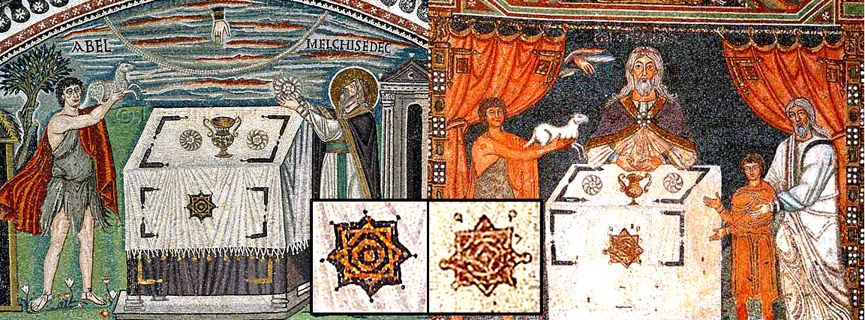
Left: Mosaic of Abel and
Melchizedek from the Basilica of San Vitale, Ravenna,
Italy (Byzantine)
Right: Mosaic of Abel, Melchizedek and Abraham with Issac
from the Basilica of Saint Apollinaire in Classe, Ravenna,
Italy (Byzantine)
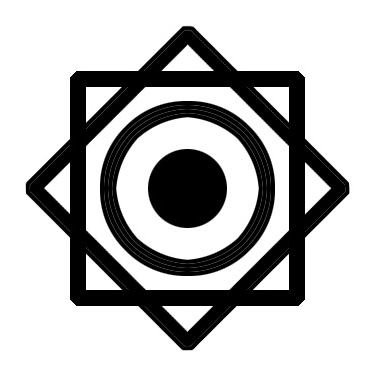
 The
Seal of Melchizedek
The
Seal of Melchizedek
This
seal to the
far left is
found on the front of the table cloth of the offering table-alter (see
above)
at which Melchizedek stands and has been associated with him by
the church. Biblical scholars say that Melchizedek is officiating
the Eucharist the Christian
ceremony of Holy Communion with bread and wine as seen on the
table-alter. The Eucharist was instituted at the Last
Supper by Jesus. What these images seems to indicate is that since both
the offerings and the
seal are within the gammadia
they are related. The seal as a symbol for the Eucharist is not interpreted accurately (this
Eucharist
could not have been a ritual at this time, predating Christ by two
thousand years, but used here as a proxy). These
two scenes are only Eucharist-like because of the addition of the
offering of sacrifice, Abel's lamb and Abraham's son Issac. Sacrifice
be it animal or human is not part of the Eucharist. However, there is a
sacrifice asked for by God in a vision of Abraham (Gen 17:9). This
could be an allusion to it. As covered earlier
in the text further above sacrifice and ritual
were bedrock to evolutionary religion with both displayed here in the
mosaics. Despite the images of Abel, Issac and Abraham it most likely
is based on Genesis 14:18-20, Melchizedek's meeting with Abraham:
And he blessed him said,
Blessed be Abram by God Most High,
maker of heaven and earth;
and blessed be God Most High,
who has delivered your enemies into your hand!"
This is what I have found concerning the origin for the naming of the seal of Melchizedek:
"I
want to note again that to date I have not found any evidence for this
symbol being called the “seal of Melchizedek” by
any other
scholar, historian, or historical figure in recorded history before
Hugh Nibley and Michael Lyon. That doesn’t mean it
doesn’t
exist, but it is likely a conception that began with the Latter-day
Saints, making a logical connection between the symbol and the Biblical
figure found adjacent to it in the mosaics."
(http://www.templestudy.com/2012/07/14/seal-melchizedek-part-5/)
That's an important quote because it gives you a straightforward historical context to understand the application of the phrase the "seal of Melchizedek." It is modern, very modern. The seal symbol is used by the LDS, the Latter Day Saints or also known as the Mormons, but more as a symbol of Christ than Melchizedek. The first time I saw this design as his seal it made no sense to me and I soon forgot about it. But as I was looking for an image I could use of Melchizedek on this page I came across it once again after having so recently read the Urantia Book papers about Melchizedek. I was struck by its abstraction of the three concentric circles which represents of the Paradise Trinity, Melchizedek's adopted insignia, and is the symbol for the Urantia Book the fifth epochal revelation of truth on the planet. "Very few of his followers ever knew that these three circles were emblematic of the infinity, eternity, and universality of the Paradise Trinity of divine maintenance and direction." (UB 1016) This was my beginning of trying to make sense of how this design could relate to his true symbol. If Melchizedek taught anything about the Trinity perhaps it is in line with this statement from the Book:
"Notwithstanding there is only one Deity, there are three positive and divine personalities of Deity. Regarding the endowment of man with the divine Adjusters, the Father said, "Let us make mortal man in our image." Repeatedly throughout the Urantian writings there occurs this reference to the acts and doings of plural Deity, clearly showing recognition of the existence and working of the Sources and Centers." (UB 110)
Melchizedek dressed as a Canaanite priest wore upon his chest the emblem of the three concentric circles. It was the only symbol associated with him. According to the UB the symbol of the three concentric circles was held so sacred that it dared not be used. It simply was too holy and was forgotten within several generations of his leaving. But this first symbol is not the circles symbol but it is something like it and it is associated with Melchizedek. So what could it possibly mean and how did it come to be? Evidence shows that it was being used at the time of the founding of Christianity and that they believed that this symbol was somehow affiliated with Melchizedek.
I suppose there are many interpretations that can be derived from this symbol but in the end it is still attached to Melchizedek as his only known symbol. I have seen those interested in this subject pursue ancient examples of concentric circles most notably from ancient Tartessos on the Atlantic coast of Spain but many others as well. The Urantia Book says this symbol was forgotten within a few generations of his leaving. So it is my opinion that any connection of ancient concentric circles with Melchizedek no matter how well intentioned is really a dead issue. But the trinity concept lived on as well as the claim of his divinity. In 2 Enoch he did have an emblem associated with him. The fact that the seal is geometric and worn on robes seems to confirm that something was remembered. This seal in the archaeological sense is early Coptic from Egypt and the Urantia Book confirms that there were present those Salem missionaries and apparently in large enough numbers for Egypt to be considered as one of the three main locations of settlement. Their teachings influenced the Pharaoh Ikhnaton and Moses. It later spread to Greece and the Roman Empire with that Coptic symbol embedded in the mosaic of the basilicas in Italy.
 What
about the part of the design, the interlocking squares? First it
is most likely Coptic but not Egyptian. This is based on the Coptic
textiles, the grave goods. The Coptics did not use the most popular
Egyptian designs.
What
about the part of the design, the interlocking squares? First it
is most likely Coptic but not Egyptian. This is based on the Coptic
textiles, the grave goods. The Coptics did not use the most popular
Egyptian designs.
"Coptic
textiles are distinguishable from earlier Egyptian Textiles in that
they do not use many of the well-defined motifs characteristic of
Egyptian design. Coptic textiles do not use the lotus and papyrus
motifs, nor do they feature the ancient styles of figures with heads
and limbs in profile view and torsos in frontal view."
(researcharchive.calacademy.org/research/anthropology/coptic/Style.htm)
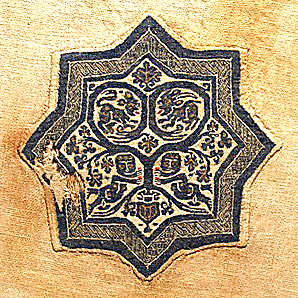 "Of
course, where would we be without making a connection back to
Egypt. Ancient Egyptian Coptic textiles have been discovered
which
mirror very closely the symbols in the Ravenna
mosaics. Indeed,
the Ravenna mosaics may have been the result of intermingling with
Egyptian culture, or originated directly from the Christians in
Egypt. A book entitled Catalogue of textiles from
burying-grounds
in Egypt by Albert Frank Kendrick published in 1920 is very instructive
relative to these textiles, and is freely available for download from
Google Books. What is also fascinating is that Kendrick also
connects the gammadia on the Ravenna mosaic altar cloths with the
gammadia found on Egyptian Coptic garments (which Tim Barker also notes
well):
"Of
course, where would we be without making a connection back to
Egypt. Ancient Egyptian Coptic textiles have been discovered
which
mirror very closely the symbols in the Ravenna
mosaics. Indeed,
the Ravenna mosaics may have been the result of intermingling with
Egyptian culture, or originated directly from the Christians in
Egypt. A book entitled Catalogue of textiles from
burying-grounds
in Egypt by Albert Frank Kendrick published in 1920 is very instructive
relative to these textiles, and is freely available for download from
Google Books. What is also fascinating is that Kendrick also
connects the gammadia on the Ravenna mosaic altar cloths with the
gammadia found on Egyptian Coptic garments (which Tim Barker also notes
well):
A mosaic in S. Vitale,
representing the Sacrifices of Abel and Melchizedek, shows an
altar-covering with angular ornaments, and a large eight-pointed star
in the middle. Numerous ornamental details of the mosaics at
Ravenna also resemble in a remarkable way the more elaborate patterns
of the stuffs from Egypt… It should also be remembered that,
although none of the Ravenna mosaics are earlier than the fifth
century, many of the ornamental details were survivals of patterns used
at an earlier date.”
(http://www.templestudy.com/2012/07/14/seal-melchizedek-part-5/)
 This next symbol and is another
related geometrical shape which is revered in Islam, it can be
found in the architecture of
the mosques. It is known as the eight
pointed star or the Al-Quds star. It
appears that it is a
derivation on the seal of Melchizedek.
This next symbol and is another
related geometrical shape which is revered in Islam, it can be
found in the architecture of
the mosques. It is known as the eight
pointed star or the Al-Quds star. It
appears that it is a
derivation on the seal of Melchizedek.
"After the
fall of
Constantinople the beauty of its decorative system was promptly copied
by the Mohammedans, quick to perceive a means of beautifying without
the use of animal forms, interdicted by the Koran, and we trace this
Byzantine influence through the Anatolian Peninsula and the Caucasus."
(http://lds-studies.blogspot.com/2011/05/seal-of-melchizedek-eight-pointed-star.html)
Both Judaism and Islam trace
their way back to Abraham. From an empirical
point of view it does appear the two symbols are related. I am sure you
have seen it
before it is a prominent
symbol. If this is a coincidence then it certainly is an amazing
one.

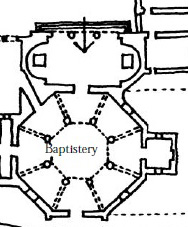
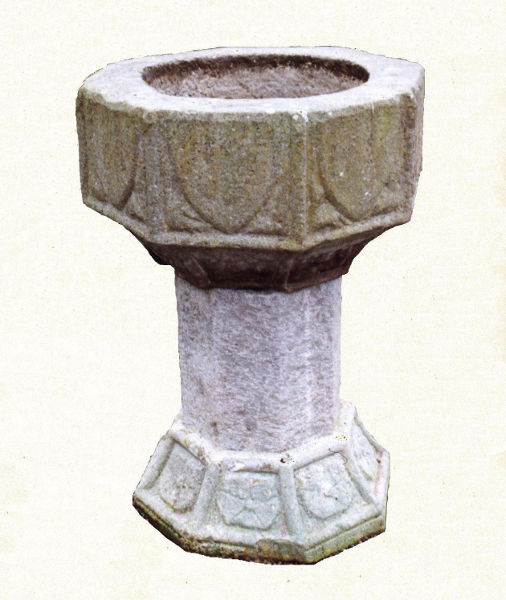 Now
we address the octagon that is created by the two overlapping squares,
the shape of the baptismal font. A font for the water of
baptism and for the fire of baptism by the Virgin of the
Light. The
Gnostics have a mythic alternate symbolism on baptism and
Melchizedek. That would be pertaining
to his
dominion of the water of the baptism and the fire of the Virgins of the
Light.
The octagon is the symbol for baptism and was incorporated into some
church
architecture. The second image is from the floor plan for the Lateran
Baptistery 461-8 AD. Baptismal fonts are not
only octagon which was most popular with the western churches but also
circular and square. At the time of Jesus people were baptized in the
river.
Now
we address the octagon that is created by the two overlapping squares,
the shape of the baptismal font. A font for the water of
baptism and for the fire of baptism by the Virgin of the
Light. The
Gnostics have a mythic alternate symbolism on baptism and
Melchizedek. That would be pertaining
to his
dominion of the water of the baptism and the fire of the Virgins of the
Light.
The octagon is the symbol for baptism and was incorporated into some
church
architecture. The second image is from the floor plan for the Lateran
Baptistery 461-8 AD. Baptismal fonts are not
only octagon which was most popular with the western churches but also
circular and square. At the time of Jesus people were baptized in the
river.
Gnosticism as theorized by Friedlander originated within
Diaspora Judaism around the time of Jesus. They were considered as
heretics by Rabbis and church fathers alike. They did keep some of
their religious beliefs while disregarding others. The following
translation
is from the 2
Book of Jeu which
was written in Coptic and is part of the Bruce Codex (the same Bruce
who rediscovered the 1 Book of Enoch). The book is incomplete. This
quote is a
mythical offering up of a prayer by Jesus calling
on the Father to send
fifteen "helpers" and asking Melchizedek to
bring the baptismal water:
"May they come and baptize my disciples in the water of life of the seven virgins of the light and forgive their sins, and purify their iniquities and number them among the inheritance of the Kingdom of the Light. If now you have heard me and have had mercy on my disciples, and if they are reckoned in the inheritance of the Kingdom of the Light, and if you have forgiven their sins and erased their iniquities, may a sign happen. And may Zorokothora come and bring forth the water of the baptism of life in one of these pictures of wine."
A second prayer similar to the first one has Jesus asking that Melchizedek again bring the baptismal water:
"...And
purify them all and cause Zorokothora Melchizedek to come in secret and
bring the water of the baptism of fire of the Virgin of the Light, the
judge. ...Hear me, my Father, father of all fatherhoods, infinite
Light, as I call upon imperishable names which are in the Treasury of
the Light. Cause Zorokothora to come and bring the water of the baptism
of fire of the Virgin of the Light, that I may baptize my disciples in
it..."
(Briger A. Pearson, Gnosticism,
Judaism, and Egyptian Christianity, Fortress Press ex
libris publication © 2006)
As you have noticed our Melchizedek has a first name, Zorokothora, and I believe you will only find it within the Gnostic literature. The Gnostics who were those disenfranchised Jews that left the Levant and more or less their religion who embraced a heretical form of Christianity (and thus despised by Rabbis and Christians) had some knowledge that Melchizedek did have a first name and according to the Urantia Book his real name is Machiventa Melchizedek. But whether they really knew he had a personal first name is debatable. They also changed the name of Jesus to Aberamentho.
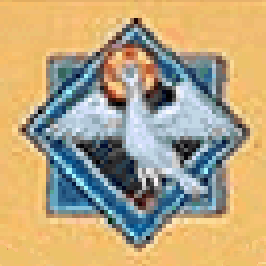

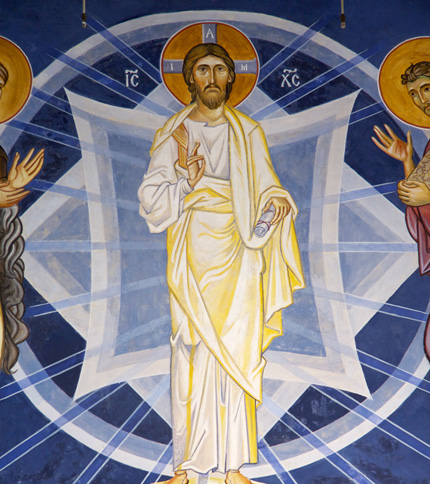
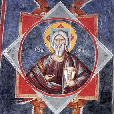 Baptism
has two parts: water and fire the symbolic light.
The image
of the dove within the overlapping squares represents the Holy Spirit
or Holy Ghost. Almost all of the baptismal depictions of Christ
being baptized by John the Baptist have the dove directly above. These
are rare images of the
overlapping squares as it relates to the Divine Light. The squares by
themselves are
mostly used in
relation to the transfiguration of Christ and almost all of it is
Eastern Orthodox and clearly is associated with the emanation of light,
the Kingdom of Light. Even more rare is the use for the nimbus which
serves the same purpose for radiating light. The last image is Serbian
and is titled the Ancient of Days. The squares are painted red and blue
may represent fire and water. These squares
are interlocked because they
represent baptism and are rotated because they are different aspects of
the same thing, one of water and one of fire or light. Melchizedek's
role from the Gnostic tradition is of the bringer of the baptismal
water which is used as water but
symbolically as fire.
Baptism
has two parts: water and fire the symbolic light.
The image
of the dove within the overlapping squares represents the Holy Spirit
or Holy Ghost. Almost all of the baptismal depictions of Christ
being baptized by John the Baptist have the dove directly above. These
are rare images of the
overlapping squares as it relates to the Divine Light. The squares by
themselves are
mostly used in
relation to the transfiguration of Christ and almost all of it is
Eastern Orthodox and clearly is associated with the emanation of light,
the Kingdom of Light. Even more rare is the use for the nimbus which
serves the same purpose for radiating light. The last image is Serbian
and is titled the Ancient of Days. The squares are painted red and blue
may represent fire and water. These squares
are interlocked because they
represent baptism and are rotated because they are different aspects of
the same thing, one of water and one of fire or light. Melchizedek's
role from the Gnostic tradition is of the bringer of the baptismal
water which is used as water but
symbolically as fire.
"John answered, saying
unto them all,
I
indeed baptize you with water; but one mightier than I cometh,
the
latchet of whose shoes I am not worthy to unloose;
he shall baptize you
with the Holy Ghost and with fire."
Luke 3:16 KJV
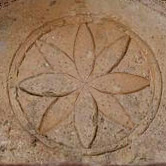
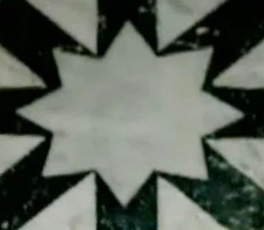
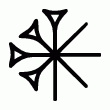 On
a page titled LDS Studies I found more helpful information about this
symbol. It starts with a quote from Constantin Marinescu Martin on a
short discourse of the "concept of Divine Light." According to Marin
there were two symbols in this regard. The first is the eight pointed
star to the left and the second the one created by the overlapping
squares which
early Christians
referred to as the "Star of Nativity." The eight pointed star, the
first star, has been
discussed elsewhere on this site which is Sumerian in origin and is
Inanna's rosette which links her directly to the Tree of Life and is
also used more abstractly as the cuneiform symbol known as the dingir
which is used within the text to denote divinity to whatever name
follows it. John P. Lundy noted that the Mesopotamian star "similarly
represented
the Divine and human in union, and he theorized that in ancient Assyria
and Babylonia the eight pointed star probably had some symbolism
representing initiation into the ancient mysteries." In addressing the
second star of overlapping squares "Marin asserts that it
represents
"Melchizedek's Sacrifice," and "receives,
in the context of Holy Text, the power of a symbol expressing the
Divine Essence of Melchizedek." In this connection Melchizedek is
linked with the eight-pointed star and is given divine status - a
concept that dates as far back as the first century B.C. in the 11Q13
(or 11QMelch fragment) from the Dead Sea Scrolls. The
connection
between the eight-pointed star and divinity is traced by Marin to St.
Gregory Palamas, the 14th century apologist for Hesychasm (an ascetic
approach to spirituality by prayer and meditation in an effort to
coerce revelation), who asserted a distinction between the concept of
God the Being and His energy, or the "presence of Grace in the form of
light that surrounded Christ in His Transfiguration on Mt.
Tabor."
On
a page titled LDS Studies I found more helpful information about this
symbol. It starts with a quote from Constantin Marinescu Martin on a
short discourse of the "concept of Divine Light." According to Marin
there were two symbols in this regard. The first is the eight pointed
star to the left and the second the one created by the overlapping
squares which
early Christians
referred to as the "Star of Nativity." The eight pointed star, the
first star, has been
discussed elsewhere on this site which is Sumerian in origin and is
Inanna's rosette which links her directly to the Tree of Life and is
also used more abstractly as the cuneiform symbol known as the dingir
which is used within the text to denote divinity to whatever name
follows it. John P. Lundy noted that the Mesopotamian star "similarly
represented
the Divine and human in union, and he theorized that in ancient Assyria
and Babylonia the eight pointed star probably had some symbolism
representing initiation into the ancient mysteries." In addressing the
second star of overlapping squares "Marin asserts that it
represents
"Melchizedek's Sacrifice," and "receives,
in the context of Holy Text, the power of a symbol expressing the
Divine Essence of Melchizedek." In this connection Melchizedek is
linked with the eight-pointed star and is given divine status - a
concept that dates as far back as the first century B.C. in the 11Q13
(or 11QMelch fragment) from the Dead Sea Scrolls. The
connection
between the eight-pointed star and divinity is traced by Marin to St.
Gregory Palamas, the 14th century apologist for Hesychasm (an ascetic
approach to spirituality by prayer and meditation in an effort to
coerce revelation), who asserted a distinction between the concept of
God the Being and His energy, or the "presence of Grace in the form of
light that surrounded Christ in His Transfiguration on Mt.
Tabor."
"Melchizedek's connection with light pre-dates Hesychasm, and his elevated status with deity pre-dates the Ravenna mosaics, to a period and location contemporary with the emergence of the eight-pointed star. Marin's identification of the eight-pointed star as a symbol of the "Divine Essence of Melchizedek" most likely finds its origin with the Egyptian Copts. As I've noted elsewhere, the symbol of the eight-pointed star on the altar cloths in the Ravenna mosaics originated from Coptic textiles in Egypt. Walter Lowrie stated that "...there can be no doubt from which art the design was derived, for it appears on the textiles four centuries earlier than it does in stone reliefs," and the "embroideries found in the Coptic graves of Egypt correspond perfectly with the designs of textile fabrics--curtains, altar cloths and dress--which are represented in the sixth century mosaics at Ravenna." Albert Kendrick published images of eight-pointed stars found on various textiles from Egyptian graves in Akhmim, Egypt, dating from the second to the fifth centuries, A.D,16 and R. Meyer-Riefstahl noted that Akhmim had been a particularly significant source for Coptic textiles."
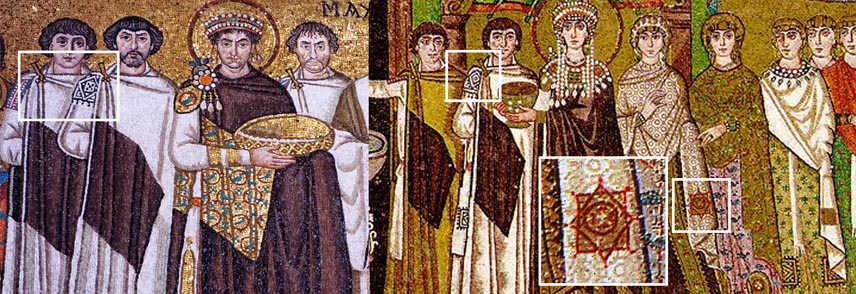
The above mosaics from San Vitale show the Byzantine emperor Justinian and his Queen Theodora with the symbol of the eight pointed star of Melchizedek. Both images contain a Priest of Melchizedek to their immediate right and the Queen with an attendant to her left with this same symbol. Notice the elaborate knot at the right shoulder of the priests. In discussing early Christian Coptic burials in Egypt Griggs observed that "Two robes contained a complex knot over the left shoulder, while eight robes contained this knot over the right shoulder, which may indicate "sacerdotal, or priestly, authority." The linen closest to the body, on some of the mummies observed, contained "small rosettes" that were woven into the material over each breast and over the right knee (but not the left), and across the lower abdomen was a hemmed slit about six inches long."
"Among the many Christian and Gnostic texts discovered, such as the Gospel of John at Antinoe, portions of the Book of Exodus at Akhmim, and a fragment containing the Apocryphal Gospel of Peter, the Apocalypse of Peter, and the Book of Enoch at Akhmim, were many other texts scattered throughout Egypt. Approximately 55 miles southeast of Akhmim was Nag Hammadi. Among the treasure trove of Coptic Gnostic texts discovered outside of Nag Hammadi, is Melchizedek XI, believed to have been written in the 2nd century A.D. Of this text, J. Davila notes that Melchizedek is characterized as an "Exalted Patriarch, as Principal Angel and Future Ideal Figure (both Divine Warrior and Eschatological High Priest)..."
"Other apocryphal and Gnostic literature that originated in Egypt have particular relevance to Melchizedek. The Pistis Sophia and the Second Book of Jeu were both written in the first couple centuries A.D., and these texts also identify Melchizedek as a heavenly being. Both of these texts also recognized a direct association between Melchizedek and divine light. The Pistis Sophia calls Melchizedek the "Paralemptor [i.e., receiver] of the Light," and the Second Book of Jeu calls Melchizedek the "ambassador' of the Lights." He is frequently identified, implicitly, as a high priest. These three texts discuss Melchizedek in a role foreign to the restored gospel, but are helpful in ascertaining some historical perspectives of Melchizedek. It appears that the conceptions of Melchizedek were as varied then as they are today."
"It
is interesting to note that Welch points out the cosmological role of
Melchizedek within Gnosticism as well. With respect to the
Melchizedek mosaic in San Vitale, Bruce Harbert suggested that the
Eucharist was "set in a historical as well as cosmological context."
This context must be inferred from the presence of the eight-pointed
star and the hand of God reaching through the heavens. Given that stars
provide both light and are set in the cosmos, and Melchizedek is known
in Gnostic literature as the receptor of lights and has
responsibilities over the cosmos, the connection between the star and
Melchizedek may have some foundation in Coptic Gnosticism. It may be no
less coincidental that much of the apocryphal literature pertaining to
Melchizedek originates in Egypt, and is from the same era and locale as
the emergence of the eight-pointed star. It should also be noted that 2
Enoch asserts that Melchizedek was born with the "seal of the
priesthood" upon his chest. This pseudopigraphical text is believed to
date to the 1st century A.D., and in addition to the primary
medieval-Slavonic text, Coptic fragments of this text have recently
been discovered in Egypt. While the seal mentioned in 2 Enoch is not
specifically identified, it does tend to indicate that each of the
elements discussed (the eight-pointed star, Melchizedek literature, and
divine light) may have originated or at least received strong emphasis
in Coptic Egypt. Marin's identification of the eight-pointed star with
divine light, as well as his connection between Melchizedek and a
deified role, appears to coincide with archaeological discoveries of
textiles and literature in Greco-Roman Egypt. However, without an
explicit identification yet discovered in antiquity, it seems that any
identification of the eight-pointed star as the "seal of Melchizedek"
would most likely have derived from Coptic Egypt in the first couple
centuries A.D."
(http://lds-studies.blogspot.com/2012/05/eight-pointed-star-melchizedek-and.html)
This Gnostic story of Melchizedek from 2 Enoch certainly grabs the attention of Urantia Book readers. It contains what I would call corrupted elements of the true story of Melchizedek. The first deals with his miraculous birth from his mother who is named Sothonim and who was "being sterile and without having slept with her husband" Nir. It was a virgin birth as such which addresses the no father issue. She is summoned to the temple by Nir who is a priest and sees his now pregnant wife who then dies at his feet. Nir goes to get his brother Noah and when they return to the temple they find Melchizedek sitting next to his deceased mother with "his clothing on him" and was fully developed physically with the ability of speech for he "blessed the Lord." Nir is actually Lamech in this story which is concerned with the priestly line of Enoch. The second element concerns the Melchizedek symbol:
"It
is of great significance that the newborn child was marked by the sign
of priesthood. The story describes how "the badge of priesthood" was on
his chest, and it was glorious in appearance. Nir and Noah dressed the
child in the garments of priesthood and they fed him the holy bread.
They decided to hide him, fearing that the people would have him put to
death. Finally, the Lord commanded His archangel Gabriel to take the
child and place him in "the paradise Eden" so that he might become the
high priest after the Flood. Final passages of the short recension
describe the ascent of Melchizedek on the wings of Gabriel to the
paradise Eden."
(http://www.marquette.edu/maqom/melchizedek.html)
This
Gnostic story of all places has those elements from the story in the
Urantia Book. They would be that Melchizedek did appear as "fully
developed physically", he had no earthly parents, he wore his insignia
on his breast and to that odd detail of the "paradise of Eden" he did
incarnate from a location somewhat analogous to it. The mention of Eden
connects him although rather obliquely to Eve the Sumerian Inanna. This
story also connects him to
Enoch and
Seth of the Jewish tradition of priestly lineage. This priesthood also
connects Melchizedek to Jesus who is "a high priest after the order of
Melchizedek." (Hebrews 5:7) And this material was
remembered from about the times of the Babylonian editing.
In the Justinian and Theodora
mosaics above you
will notice that the symbols are marked upon the robes of the priests.
This is a tradition that dates back at least to the
priests of ancient Israel. Under these robes were the white linen
clothing just like the
above mosaics of Melchizedek, Justinian and Theodora illustrate. "A
prominent scholar of biblical texts has taught that the marks on the
ancient Israelite garments were constructed in such a way so as to make
each one of them “a symbol of both priesthood and royalty,
thereby epitomizing the divine imperative that Israel become
‘a
kingdom of priests and a holy nation.’”
(http://www.templestudy.com/2011/02/24/sanctuary-vesture-overview-comparison/)
Although it may seem like an obvious thing to do as displaying holy icons this way I cannot shake the idea that this practice of the priestly caste was influenced by Melchizedek who did the same thing.
2 Enoch was not found as a complete book but rather as a group of more than twenty medieval Slavonic manuscripts and fragments dated from the 14th to the 18th century. Scholars believe the manuscripts were translated from the Greek version which possibly have a semitic origin. In 2009 four fragments written in Coptic have been identified.
 This
is the Coptic cross. It is an equilateral cross with arms of equal
length.
It is overlaid upon the seal of Melchizedek to show you how this
geometric design is applied to the cross. It also mimics intentionally
or not the fleur-de-lys,
that
emblem of the garden of Eden. Seeing as how the center rosette of the
design which is visible in the cross is linked to Eden as is the iconic
fleur-de-lys
it is
impossible to really know if this part of the design is merely created
by its underlying geometry or if its a clever display of yet another
hidden symbolism. Perhaps both.
This
is the Coptic cross. It is an equilateral cross with arms of equal
length.
It is overlaid upon the seal of Melchizedek to show you how this
geometric design is applied to the cross. It also mimics intentionally
or not the fleur-de-lys,
that
emblem of the garden of Eden. Seeing as how the center rosette of the
design which is visible in the cross is linked to Eden as is the iconic
fleur-de-lys
it is
impossible to really know if this part of the design is merely created
by its underlying geometry or if its a clever display of yet another
hidden symbolism. Perhaps both.

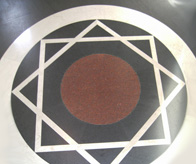 In
the Roman Catholic church the symbol still survives. To the left is a
picture of Pope John Paul II in his vestments and at the bottom of his
robe are the symbols of the seal of Melchizedek. Click on the image for
a larger size. The next
picture is from the floor of the Vatican Museum. It is not surprising that
the church has kept many of the
ancient symbols, some considered as pagan, and still uses them. Those
who would deride the church because of this do not know their history
nor the positive meaning of these symbols.
In
the Roman Catholic church the symbol still survives. To the left is a
picture of Pope John Paul II in his vestments and at the bottom of his
robe are the symbols of the seal of Melchizedek. Click on the image for
a larger size. The next
picture is from the floor of the Vatican Museum. It is not surprising that
the church has kept many of the
ancient symbols, some considered as pagan, and still uses them. Those
who would deride the church because of this do not know their history
nor the positive meaning of these symbols.
As an
additional interest the seal of Melchizedek can also be found with the
Masons:
"Another
place we find the eight-pointed star is none other than in Freemasonry,
and this time it is directly associated with Melchizedek." (http://www.templestudy.com/2012/07/14/seal-melchizedek-part-5/)
 The
Freemasons have roots in Egypt. Note the triad of words. This shows up
again and again
with the symbol. Sometime different words but a triad just the same.
Here as Peace, Tolerance and Truth but also includes Divine
Omnipotence, Omniscience and Omnipresence and also
Universal,
Infinite and
Eternal among others. There is nothing in the symbol to suggest that
its meaning is
triadic. Yet descriptions are almost alway in threes. And three
descriptions associated with it are much in line with the original
symbol for Melchizedek with its original description for the
Trinity.
The
Freemasons have roots in Egypt. Note the triad of words. This shows up
again and again
with the symbol. Sometime different words but a triad just the same.
Here as Peace, Tolerance and Truth but also includes Divine
Omnipotence, Omniscience and Omnipresence and also
Universal,
Infinite and
Eternal among others. There is nothing in the symbol to suggest that
its meaning is
triadic. Yet descriptions are almost alway in threes. And three
descriptions associated with it are much in line with the original
symbol for Melchizedek with its original description for the
Trinity.
Up to this point we have been discussing the two symbols for the eight pointed star for the seal of Melchizedek, the eight petaled star shaped rosette and the overlapping squares of the "Star of the Nativity," both are religious in nature. That has been my understanding. Whether what is being called an eight pointed star is the rosette or is a star cannot be determined from text alone without a supporting illustration. So some descriptions by text only are open to interpretation.
 The
picture to the far left is a stone relief from Mogador
Essaouira Morocco which is north African just as
is Egypt. In its
center is clearly depicted the eight petal rosette which could be
the dot in the center of many representations of the seal of
Melchizedek. I
discovered this image as I was
looking for the shape of the two squares and why the small dots are
attached to it in the San
Vitale image. I thought these dots may be
related to the
budded cross of the
Armenian Church. If you look at the San Vitale
picture next to it there
are the eight dots as part of the design. They are really diamond
shapes just like the stone relief. I first
suspected that what
we have here are two designs imposed upon one another: the internal
rosette and the overlapping squares. And that would
makes
sense although there is nothing in the literature to support this
conclusion. The rosette was known and was being used at the time of
Abraham in Mesopotamia. (The opening poem at the top of the page about The
Huluppu Tree is also from this same time period.)
The rosette is more ancient than the overlapping squares as attested in
the archaeological record. The rosette being connected with the Goddess
Inanna connotes two things: Kingship and Religious Authority both apply
to Melchizedek, Jesus and for the longest time the Christian church.
(King Henry the Eighth established the Church of England apart from the
Roman Catholic Church because the Pope would not allow him an annulment
of his marriage to his wife Katharine of Aragon. It shows that the Pope
was more powerful than the king).
The
picture to the far left is a stone relief from Mogador
Essaouira Morocco which is north African just as
is Egypt. In its
center is clearly depicted the eight petal rosette which could be
the dot in the center of many representations of the seal of
Melchizedek. I
discovered this image as I was
looking for the shape of the two squares and why the small dots are
attached to it in the San
Vitale image. I thought these dots may be
related to the
budded cross of the
Armenian Church. If you look at the San Vitale
picture next to it there
are the eight dots as part of the design. They are really diamond
shapes just like the stone relief. I first
suspected that what
we have here are two designs imposed upon one another: the internal
rosette and the overlapping squares. And that would
makes
sense although there is nothing in the literature to support this
conclusion. The rosette was known and was being used at the time of
Abraham in Mesopotamia. (The opening poem at the top of the page about The
Huluppu Tree is also from this same time period.)
The rosette is more ancient than the overlapping squares as attested in
the archaeological record. The rosette being connected with the Goddess
Inanna connotes two things: Kingship and Religious Authority both apply
to Melchizedek, Jesus and for the longest time the Christian church.
(King Henry the Eighth established the Church of England apart from the
Roman Catholic Church because the Pope would not allow him an annulment
of his marriage to his wife Katharine of Aragon. It shows that the Pope
was more powerful than the king).
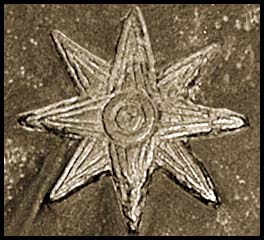

 This
stone relief is also the star of Inanna and was later called the star
of Venus. It is also known as Venus the Morning and Evening Star. It's
design
astonishingly resembles the seal of Mechizedek so much so that it may be the seal of Melchizedek. I
think it is. It
is the simplest answer to this enigma. You
can see the diamond and square emerge from the circles which is a
common form for the symbol. And as they
flatten out away from their angular origin they become the overlapping
squares of the seal of Melchizedek. The interior circle and dot remain
the same and it is still an eight pointed star. This is one of the best
examples I have seen of "hiding in
plain sight." Why others, I think, researching this symbolism missed
recognizing this star is because of its heavy association with the
rosette
which is sometimes called a star or they felt the Coptic textiles
answered the question of origin which is most likely. They
just did not follow it far back enough by going deeper into ancient
history to Inanna and her astral symbol the star of Venus. Nowhere
have I read that this particular star is the seal of Melchizedek as I
state here. I believe that that mystery of its
shape and
origin has now been solved
only to be replaced with the question of why Inanna's star, the star of
Venus?
This
stone relief is also the star of Inanna and was later called the star
of Venus. It is also known as Venus the Morning and Evening Star. It's
design
astonishingly resembles the seal of Mechizedek so much so that it may be the seal of Melchizedek. I
think it is. It
is the simplest answer to this enigma. You
can see the diamond and square emerge from the circles which is a
common form for the symbol. And as they
flatten out away from their angular origin they become the overlapping
squares of the seal of Melchizedek. The interior circle and dot remain
the same and it is still an eight pointed star. This is one of the best
examples I have seen of "hiding in
plain sight." Why others, I think, researching this symbolism missed
recognizing this star is because of its heavy association with the
rosette
which is sometimes called a star or they felt the Coptic textiles
answered the question of origin which is most likely. They
just did not follow it far back enough by going deeper into ancient
history to Inanna and her astral symbol the star of Venus. Nowhere
have I read that this particular star is the seal of Melchizedek as I
state here. I believe that that mystery of its
shape and
origin has now been solved
only to be replaced with the question of why Inanna's star, the star of
Venus?
There are many connotations connected to the star symbol of Venus. But the most important is the connection to celestial beings. Eve as Inanna would be the first as it is her star, then Melchizedek. But between Eve and Melchizedek is Adam as Shamash whose star symbol has the same origin as Eve's star. The star of Venus as the Morning Star includes two other celestials Lucifer and Jesus. The application of the Morning Star does relate Lucifer to the star and thus as a person just like Inanna, the star being a symbol for the person. But as it relates to Jesus it may be something very different. The relationship may be to another celestial the Bright and Morning Star, not to the symbol as a person but to a very high level of authority, a subject I elect not to address due to its complexity. On my page The Marriage of Adam and Eve I trace the star symbol all the way back to its origin which is that of the transport seraphim (which is another celestial being) and which I call the Din.Gir. It explains how the symbol of Shamash relates to the symbol of Inanna and the evolution of the symbol. Information on the transport seraphim and its symbolism can be found on my page The Serpent. And finally more information can be found on the page Lucifer. For some reason Melchizedek's star became squared but kept all the elements and meanings of the original star such as Eden, heaven, divinity, kingship, authority and such. It apparently lost its name as Inanna's Star of Venus but all of the associations remained intact and enlarged by the application to the transfiguration of Jesus Christ. The meaning of the seal of Melchizedek is in its hidden star of Venus, the Morning Star.
I am the root and the offspring of David, and the bright and morning star."
Revelation 22:16 King James Version
How art thou fallen from heaven, O Lucifer, son of the morning!
how art thou cut down to the ground, which didst weaken the nations!
Isaiah 14:12 King James Version
How you have fallen from heaven, you morning star, son of the dawn!
How you have been cut down to the ground, you conqueror of nations!
Isaiah 14:12 God's Word Translation
 One
last thing but it is an important last thing. Melchizedek's teachings
were based on the revelation of the Trinity - God the Father, God the
Son and God the Holy Spirit. So why use an ancient Mesopotamian symbol,
the star of Venus, for the seal of the Coptic priesthood of
Melchizedek? Because in addition the
star is part of a trinity which is the Star (Inanna), the Moon (Nanna) and
the Sun (Shamash). The image
to the left is from a Babylonian Stele with the star, the moon and the
sun grouped together at the top of the stone marker. This grouping was prevalent
during
the Babylonian times of the Salem missionaries. I was not looking for
this, it just happened. Yowza.
One
last thing but it is an important last thing. Melchizedek's teachings
were based on the revelation of the Trinity - God the Father, God the
Son and God the Holy Spirit. So why use an ancient Mesopotamian symbol,
the star of Venus, for the seal of the Coptic priesthood of
Melchizedek? Because in addition the
star is part of a trinity which is the Star (Inanna), the Moon (Nanna) and
the Sun (Shamash). The image
to the left is from a Babylonian Stele with the star, the moon and the
sun grouped together at the top of the stone marker. This grouping was prevalent
during
the Babylonian times of the Salem missionaries. I was not looking for
this, it just happened. Yowza.
The
center of civilization eventually hopscotched from Egypt to Crete and
then landed in Greece. Greece at this time had a variety of influences.
There were the dominate Mother Cult worshipers who came across the
Mediterranean from Crete and those moving west from Anatolia.
You
also had the prevailing Olympian beliefs that were a holdover from the
earlier immigration of Adamites. An Aryan influx had brought to Greece
a much more anthropomorphic concept of God, a henotheistic religion
somewhat similar to the belief in Yahweh but included subordinate gods.
As we know from history the gods of Olympus became the popular
religious belief but added nothing to the advancement of a real
religion. The Greeks excelled in a philosophic advancement and turned
to
metaphysics, self-realization and understanding, and away from self
preservation - salvation. The Greeks valued thinking over believing
while in Palestine the exact opposite was true. The Hebrews became so
priest controlled and scripture based that philosophy and aesthetics
were buried under religion and morality.
"In Greece, believing was subordinated to thinking; in Palestine, thinking was subject to believing. Much of the strength of Christianity is due to its having borrowed heavily from both Hebrew morality and Greek thought." (UB 1079)
For all
its lauded
intellectual prowess the Greek philosophers were unable to continue as
a dominate force in society due to the lack within their belief system
a personal God, and one of salvation. That void was filled by the newly
appearing mystery cults with an appealing message to the masses of
salvation and therefore immortality. It was based on an older Egyptian
religion centering around the resurrection of Osiris derived from the
springtime flooding and the regeneration of plant life along the Nile.
But it was rife with fiery ceremonials and orgies. Very popular in its
day these cults
eventually gave way to the greatest mystery cult of all - the cult of
Mithras. The cult of Mithras is Persian in origin, one which competed
with Zoroastrianism. It made its way to the Roman Empire greatly
modified by its competitor. As a matter of fact Christianity was
influenced as well. The cult and Christianity were contemporaries in
the
Roman Empire and were similar in some respects. The Achilles heal of
the cult was the fact that women were not allowed to participate in the
ceremonies in the temple but later had their own adjoining temple of
the Great Mother. But women were admitted into full fellowship in the
Christian religion and this strength lead to a domination over the cult
of Mithras.
As you can see the long evolutionary saga from aboriginal Shamanism to
modern day monotheism has had taken many twists with a number of
different
thoughts and influences. Christianity has also many different
influences including:
the Melchizedek teachings, the Hebraic system of morality, ethics and
theology, the Zoroastrian concept of the struggle between good and
evil, the mystery cults especially Mithraism, the historical fact of
the life of Jesus the fourth epochal revelation of truth, the personal
viewpoint of Paul of Tarsus and the Hellenistic philosophic thought
that was more in harmony with Paul's version of Christianity. And
finally this is what the Urantia Book has to say about Christianity
today:
"As the original teachings of Jesus penetrated the Occident, they became Occidentalized, and as they became Occidentalized, they began to lose their potentially universal appeal to all races and kinds of men. Christianity, today, has become a religion well adapted to the social, economic, and political mores of the white races. It has long since ceased to be the religion of Jesus, although it still valiantly portrays a beautiful religion about Jesus to such individuals as sincerely seek to follow in the way of its teaching. It has glorified Jesus as the Christ, the Messianic anointed one from God, but has largely forgotten the master's personal gospel: the Fatherhood of God and the universal brotherhood of all men." (UB 1084 - 5)
Thank you for reading.

If you are
unfamiliar with the Urantia Book you can read from the published
on-line versions in English, Croatian, Dutch, Finnish, French, Korean
(must have Korean character set installed), Lithuanian, Polish,
Portuguese, Russian or Spanish at: http://urantiabook.org/
which is the
Fellowship's website or at:
http://www.urantia.org/papers/index.html
which is the
Urantia Book Foundation's website.
You can also buy
a copy online or at your local bookseller.
If you want a
description of the Book, Wikipedia has a somewhat long
but neutral review. You can read it here: http://en.wikipedia.org/wiki/Urantia_Book
There are
a number of paintings on this theme on an Italian web site most of
which I have not seen elsewhere:
(http://www.scuolaecclesiamater.org/2014/06/at-vero-melchisedech-rex-salem.html)
 Introduction
Introduction Van
Van The Serpent
The Serpent Marriage of Adam
& Eve
Marriage of Adam
& Eve Tree
of Life
Tree
of Life Lucifer
Lucifer The Vanites
The Vanites